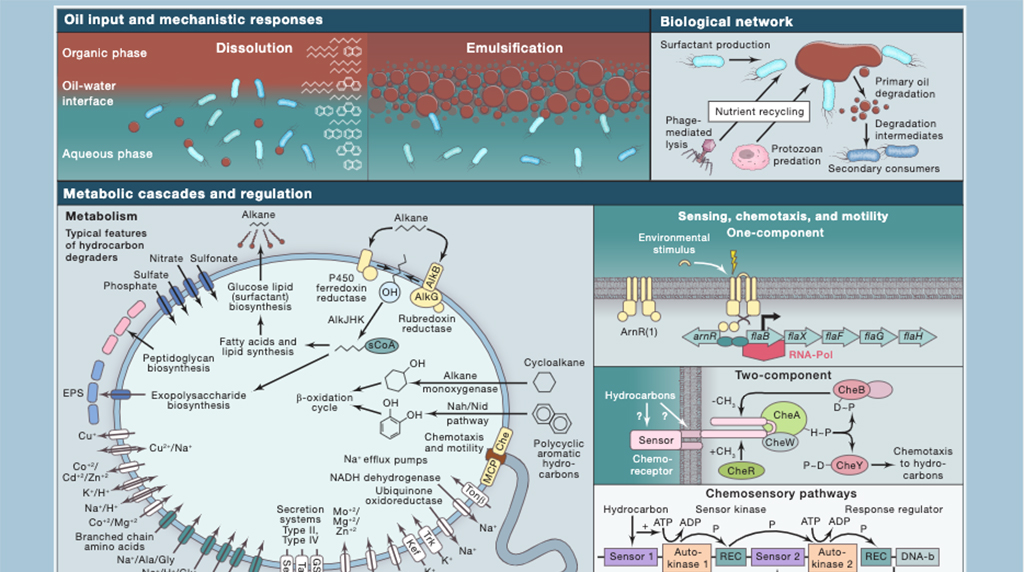May 29, 2019
Researchers compiled a two-page summary with detailed graphics explaining the complex mechanisms and processes involved in microbial hydrocarbon bioremediation. The summary explains how microbes sense and move toward hydrocarbons in their environment and communicate with other microbes about the available energy source. The document discusses how oil enters a microbial cell’s membrane and the cell’s subsequent biosurfactant production, which contributes to marine snow formation that affects oil fate. This tightly-written summary of oil bioremediation dynamics may serve as a helpful tool for microbiology teachers and their students.
The scientists published their findings in Cell: Snapshot: Microbial hydrocarbon bioremediation.
Hydrocarbon-degrading microorganisms are present in many marine habitats, albeit at low abundance, and are part of a rare biosphere that can be enriched rapidly following hydrocarbon contamination such as oil spills. Oil-degrading microbes are phylogenetically and physiologically diverse and possess unique strategies that increase hydrocarbon bioavailability. Because microbially-produced biosurfactants are biodegradable, largely environmentally benign, and function under extreme conditions, researchers are exploring their use as a natural oil dispersant.
Oil-degrading microbes can sense compound gradients, which is important to microbial chemotaxis and motility and determines if the microbes will move toward or escape from compounds in the environment. Chemotaxis likely played an important role in microbial responses to Deepwater Horizon since certain hydrocarbon-degrading microbes exhibited high motility and chemotaxis gene expression during the spill.
The study’s authors are Samantha Joye, Sara Kleindienst, and Tito David Peña-Montenegro.
************
This article was written by Nilde Maggie Dannreuther and Stephanie Ellis and originally appeared online here. Contact maggied@ngi.msstate.edu with questions or comments.
This research was made possible in part by a grant from the Gulf of Mexico Research Initiative (GoMRI) to the Ecosystem Impacts of Oil and Gas Inputs to the Gulf-2 (ECOGIG-2). Other funding sources included an Emmy-Noether fellowship (grant #326028733) from the German Research Foundation (Deutsche Forschungsgemeinschaft) and a Fulbright Columbia Fellowship.
The Gulf of Mexico Research Initiative (GoMRI) is a 10-year independent research program established to study the effect, and the potential associated impact, of hydrocarbon releases on the environment and public health, as well as to develop improved spill mitigation, oil detection, characterization and remediation technologies. An independent and academic 20-member Research Board makes the funding and research direction decisions to ensure the intellectual quality, effectiveness and academic independence of the GoMRI research. All research data, findings and publications will be made publicly available. The program was established through a $500 million financial commitment from BP. For more information, visit http://gulfresearchinitiative.org/.


















 back to top
back to top